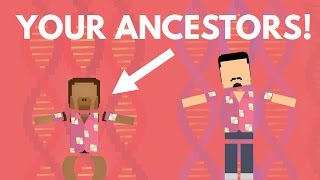Hey there! Welcome to Life Noggin.
大家好!欢迎来到脑洞大开的生命奇想。
Human evolution is incredibly complicated.
人类的进化是极其复杂的。
Around 6 to 8 million years ago, a common ancestor we share with chimps diverged genetically, with one lineage eventually giving rise to modern-day humans.
大约在6到8百万年前,我们与黑猩猩的共同祖先在基因上分化,一个谱系最终进化成了现代人类。
The path to Homo sapiens is far from straightforward and there are a lot of early-human ancestors that once existed.
进化成智人的道路不是那么直接,历史上曾经存在过许多早期人类祖先。
 But what were some of them like and how did humans get to where they are?
But what were some of them like and how did humans get to where they are?但是他们是什么样的呢?人类又是如何进化成今天这样的呢?
Let's start off with one of the most famous human-like groups: the Australopithecus.
首先我们来聊聊一个最著名的类人群体:南方古猿。
These small-brained creatures are thought to be closely related to, if not actual ancestors of, modern humans.
一般认为这些脑容量较小的生物与现代人类的祖先密切相关(如果不是真正祖先的话)。
Certain species, like Australopithecus afarensis, lived in eastern Africa around 3 to 4 million years ago, walked upright on two legs, and had ape-like faces.
某些物种,比如阿法南方古猿,大约在3到4百万年前生活在非洲东部,两条腿直立行走,脸和猿类似。
They also had strong arms and curved fingers perfect for climbing trees, making them like the short human/ape version of Tarzan -- but without the long, glorious hair.
他们也有强壮的手臂和弯曲的手指,很适合爬树,像人猿泰山的矮小人类版或者猿猴版——但没有长而有光泽的头发。
Maybe one day, animator. Next up is the species Homo habilis, which lived around 2.4 to 1.4 million years ago, also in Africa.
也许有一天会有的吧,动画师。下一个物种是能人,他们生活在大约240万到140万年前,也在非洲。
As we mentioned in a previous video, their name means “handy man” and they were able to make and use tools.
我们在之前的视频中提到过,他们的名字意思是“手巧的人”,因为他们能够制作和使用工具。
They also have ape-like features, but with smaller teeth and faces, but larger skulls compared to the Australopithecus.
它们也有类似猿的特征,但与南方古猿相比,它们的牙齿和脸更小,但头骨更大。
And based on fossil evidence, scientists believe that Homo habilis may have coexisted with another species of early humans, Homo erectus, for almost half a million years.
化石信息显示,科学家认为能人可能与另一种早期人类——直立人——共存了近50万年。
Speaking of Homo erectus, they had the most human-like body proportions out of all the species we've discussed so far, making them better equipped for life on the ground instead of climbing trees.
说到直立人,他们的身体比例比我们讨论过的所有物种都要接近人类,这使他们能更好地适应地面生活,不用爬树。
And they were quite the travelers, expanding their reach to beyond just Africa and into Asia and Europe.
他们四处迁徙,将活动范围扩大到非洲以外的亚洲和欧洲。
They lived between 1.9 million years ago and around 140,000 years ago, and during this time, they made improvements to their tools and used fires to cook food, which also conveniently kept away large predators.
它们生活在190万年前到大约14万年前,在这段时间里,它们改进了工具,用火烹饪食物,这也方便赶走大型掠食者。
Boy, do I love living in a house where those things can't get me now.
我喜欢住在房子里,那些东西就抓不到我了。
And of course, we have the Neanderthals -- our closest extinct human relative.
当然,我们还有尼安德特人——与我们最接近但是已经灭绝的人类亲属。
They lived between 300,000 and 30,000 years ago and are known for their large, receding forehead and distinct brow ridges.
他们生活在30万到3万年前,最出名的是他们巨大的前额和明显的眉骨。
And I hope they tell me where they get their brows done, because they look incredible.
我希望他们能告诉我他们的眉毛在哪里做的,因为他们的眉毛看起来很特别。
They were also short and stocky, which was an evolutionary adaptation to the cold conditions they were living in. And like modern humans, they buried their dead.
它们也矮而健壮,这是进化过程中对寒冷生活条件的适应。和现代人类一样,他们也会埋葬死者的尸体。
And interestingly, when modern humans first started moving out of Africa at least 60,000 years ago, they met with Neanderthals and mated with them.
有趣的是,当现代人类在6万年前第一次走出非洲时,他们遇到了尼安德特人并与他们通婚。
But the Neanderthals didn't just stop there -- they also interbred with another species called the Denisovans.
但是尼安德特人并没有止步于此,他们还与另一种叫做丹尼索瓦人的物种通婚。
Modern humans did this too, which is why some present-day people have Denisovan DNA. But what else did Homo sapiens do besides interbreeding?
现代人也这么做了,这就是为什么现在有些人有丹尼索瓦人的DNA。除了与其他种族通婚,智人还做了什么?
Well, as they experienced changing climates and moved across the globe, they continued to adapt to their environment.
他们经历了气候变化并在全球范围内迁移,继续适应生活环境。
They had larger brains than their early ancestors, which they needed in order to deal with the growing complexity of their tools, culture, and language.
他们的大脑比早期祖先的更大,他们需要大脑来处理日益复杂的工具、文化和语言问题。
They developed agriculture and improved upon their technology, which eventually led to the creation of everything we have today.
他们发展了农业,并改进了技术,最终产生了我们今天所拥有的一切。
Needless to say, it will be very interesting to see where the future of human evolution takes this species. Seeing is how much change there has already been.
毫无疑问,看到人类进化的未来将会对这个物种产生什么影响将是非常有趣的。我们已经看到了人类进化的巨大变化。
Hey, are you curious if you could survive 2.5 million years ago?
嘿,你有没有好奇过,250万年前你能活下来吗?
During the peak periods where most of the water on Earth was ice, the global average temperatures were 5 to 10 degrees Celsius colder than they are today.
在这段时间地球上大部分水都是冰,全球平均温度比现在低5到10摄氏度。
I'm Blocko and this has been Life Noggin. Don't forget to keep on thinking!
我是宝高,这里是脑洞大开的生命奇想。思考不要停!











